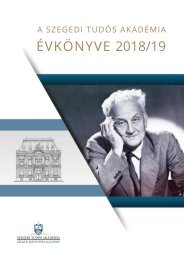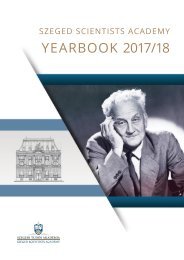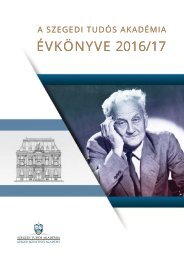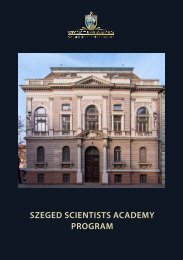SzSA YearBook 2016/17
Create successful ePaper yourself
Turn your PDF publications into a flip-book with our unique Google optimized e-Paper software.
SZENT-GYÖRGYI MENTORS<br />
IMRE MIKLÓS BOROS<br />
Institute of Biochemistry, Biological Research Center of<br />
Hungarian Academy of Sciences<br />
Department of Biochemistry and Molecular Biology,<br />
University of Szeged<br />
Address: Közép fasor 52., H-6726 Szeged, Hungary<br />
E: borosi@bio.u-szeged.hu<br />
T: +36 62/544-686<br />
RESEARCH AREA<br />
Technical development during the last decade resulted<br />
in the arrival of a post-genomic area of modern biology.<br />
Thanks to the rapid advance in nucleic acid sequencing and<br />
related technologies the scientific focus related to structure<br />
and function of individual genes has shifted to studies<br />
concerning organization and interactions of complex gene<br />
networks and the whole genome. The laws of epigenetics,<br />
which govern inheritance not fixed in the DNA sequence,<br />
are being recognized nowadays. There are realistic hopes<br />
that the new data on functioning of the genome will improve<br />
our life directly by providing grounds for life style recommendations<br />
and personalized medical treatments, just<br />
to mention a few aspects.<br />
We study gene regulation in different models with the aim<br />
of understanding the role of proteins involved in the packaging<br />
of DNA into chromosomes. The action of these proteins<br />
determines whether a particular gene can manifest its<br />
action or not. Consequently, by changing the activity of<br />
these chromatin modifier proteins, specific gene functions<br />
can be altered intentionally.<br />
TECHNIQUES AVAILABLE IN THE LAB<br />
The techniques we use for studying gene regulation are<br />
among the most advanced ones available in the field. These<br />
include techniques of gene engineering, culturing of different<br />
cell types and measuring gene activity by various means.<br />
Ongoing development further supports our work by<br />
applying the most advanced next-generation sequencing<br />
in our studies.<br />
SELECTED PUBLICATIONS<br />
Borsos, B.N., Huliák I., Majoros, H., Ujfaludi, Z., Gyenis,<br />
Á., Pukler, P., Boros, I.M., Pankotai, T. (20<strong>17</strong>) Human p53<br />
interacts with elongating RNAPII complex and is required<br />
for the relese of actinomycin D induced transcription<br />
blockade. Sci Rep 7: 40960.<br />
Vedelek, B., Blastyak, A., Boros, I.M. (2015) Cross-Species<br />
Interaction between Rapidly Evolving Telomere-Specific<br />
Drosophila Proteins. PLOS One 10: e0142771.<br />
Borsos, B.N., Pankotai, T., Kovacs, D., Popescu, C., Pahi, Z.,<br />
Boros, IM. (2015) Acetylations of Ftz-F1 and histone H4K5<br />
are required for the fine-tuning of ecdysone biosynthesis<br />
during Drosophila metamorphosis. Dev Biol 404: 80-87.<br />
Villanyi, Z., Ribaud, V., Kassem, S., Panasenko, O.O., Pahi, Z.,<br />
Gupta, I., Steinmetz, L., Boros, I., Collart, M.A. (2014) The<br />
not5 subunit of the ccr4-not complex connects transcription<br />
and translation. PLOS Genet 10: e1004569.<br />
Sike, A., Nagy, E., Vedelek, B., Pusztai, D., Szerémy, P., Venetianer,<br />
A., Boros, I.M. (2014) mRNA Levels of Related Abcb<br />
Genes Change Opposite to Each Other upon Histone Deacetylase<br />
Inhibition in Drug-Resistant Rat Hepatoma Cells.<br />
PLOS One 9: e84915.<br />
Gyenis, A., Umlauf, D., Ujfaludi, Z., Boros, I.M., Tora, L. (2014)<br />
UVB Induces a Genome-Wide Acting Negative Regulatory<br />
Mechanism That Operates at the Level of Transcription<br />
Initiation in Human Cells. PLOS Genet 10: e1004483.<br />
Boros, I.M. (2012) Histone modification in Drosophila. Brief<br />
Funct Genomics 11: 319-331.<br />
41












